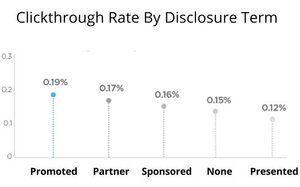
About a third of
native ad placements fail to comply with federal disclosure guidelines, according to an analysis released this morning by a leading native advertising developer.
More significantly, the study
suggests publishers may not be complying because the explicit nature of federal recommendations may not perform as well as more ambiguous approaches favored by some publishers and advertisers.
The report, Polar’s “State of Native Disclosure,” analyzed 137 native placements across 65 publishers and found only 55% of them utilized the term “sponsored”
and 4.5% used the term “advertisement,” adhering to Federal Trade Commission guidelines that native ad placements are explicitly labeled as sponsored advertising content.
The remainder either had no disclosure at all or utilized more ambiguous terms such as “promoted,” “presented,” or “partner.”
advertisement
advertisement
In guidelines it published in December 2015, the FTC said such ambiguous terminology could
potentially “mislead consumers that advertising content is endorsed by a publisher site and/or that the advertiser did not create or influence the content.
While Polar
advocated adhering to FTC guidelines, and even provided links to the FTC’s recommendations and enforcement policies, the study found that one factor may be that more obscure terms actually
perform better than explicit disclosures.
The study found the highest click-through rate (0.19%) was achieved by native ads labeled “promoted,” and the second-highest
(0.17%) by those labeled “partner” content. “Sponsored” ranked third with a click-through rate of 0.16%, while native content with no disclosure achieved a rate of 0.15%.
Interestingly, the study also found marked differences between the performance of native ad disclosures on desktop and mobile screens.
While “sponsored” actually
outperformed “promoted” by a margin of 26% on desktop pages, mobile “was a completely different story,” according to Polar, with “promoted” disclosures
outperforming “sponsored” by 105%.
The report provides much more granular analysis illustrating specific examples of labeling, highlighting and shading native ad formats on both
desktop and mobile, and the relative degree of click-through performance. It does not examine higher order effects such as conversions or consumer perceptions and attitudes toward advertisers and
publishers utilizing the formats.